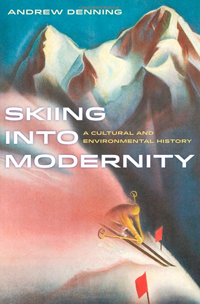How Alpine skiing changed Europe's economy and challenges its environment
LAWRENCE — When the Fascist Italian government after World War I wanted to spread leisure to the people to build support for the regime, it assisted the project of FIAT founder Giovanni Agnelli to design and build a ski resort in the Italian Alps.
 Opened in 1934, the Sestriere resort became the model of a modern ski resort: a planned community built to attract members of the Italian middle class to participate in their newly discovered favorite sport, downhill skiing.
Opened in 1934, the Sestriere resort became the model of a modern ski resort: a planned community built to attract members of the Italian middle class to participate in their newly discovered favorite sport, downhill skiing.
The attraction of the massive European mountain range and new accessibility of the sport that was previously confined largely to elites opened up new possibilities for the continent's economy as it shifted from manufacturing to tourism, especially after World War II. However, as a University of Kansas researcher has found, with few obstacles to building these resorts all over Alpine Europe, decades later, environmental consequences have become increasingly dramatic, and they might endanger what has become a major pillar of the continent's tourism economy.
"Sestriere provided the model for the postwar period as countries tried to rebuild their economies and plan for the future. They recognized that the fundamental resource in Alpine areas was the landscape and the snow, and they poured resources into developing the winter tourism industry," said Andrew Denning, assistant professor of history and author of the book "Skiing into Modernity: A Cultural and Environmental History."
The market was primed for growth as European countries were home to men who were trained as skiing troops in World War I, and in the interwar period, the sport extended further to the middle class. The image of skiing became associated with modernity in the 1920s and 1930s as the middle class became thrilled with the ability to take a motorized ski lift to a high peak and zoom down a slope at high speeds.
Sophisticated marketing also helped immensely, Denning said.
"You see skiing's importance because it's such a kinetic experience," he said. "It really is difficult for people to represent or consume either in written form or in photographs."
A classic magazine ad from the 1920s showed a skier and a new Mercedes next to each other urging the viewer to be the "master of space and time." In 1969, Hunter S. Thompson interviewed a trio of stars at the 1969 Chicago Auto Show who were touting the Chevy Camaro — a young O.J. Simpson, Chevrolet executive John Z. DeLorean and French triple gold-medalist Alpine skier Jean-Claude Killy.
Thompson wrote that by the late 1960s skiing was no longer an esoteric sport for the rich but a widely popular one as more people could afford it.
So they flocked to resorts like Italy’s Sestriere or in Austria where the government used its Marshall Plan funds after the war to extend the tourist trade by building ski lifts and reconstructing hotels in the Alps rather than rebuilding industrial plants that produced material goods.
“Winter tourism now forms a major part of the national economy in Alpine Europe,” Denning said. "These areas on average are now richer than lowland Europe, so you've really seen an inversion in the traditional relationships."
However, this shift did not come without ramifications in other areas, he said. States altered the mountains to make them conducive to skiing. They used dynamite to clear ski runs and knock down trees and built motorized lifts that attracted more people to these areas, but many complained that the mechanization of the mountainside spoiled their enjoyment of nature.
"More and more tourists put immense pressure on a fragile ecosystem, with pollution and waste overwhelming some of these small mountain communities," he said. “For a sport that depends on skiers’ proximity to nature, this creates many problems. There is a tension between mastering nature to capitalize on the sport’s popularity while also giving people a sense of escape from the industrial world."
Effects of climate change have contributed to lack of snow in some areas of the Alps, which have threatened both the environment and the economy there. No snow means less visitors. Since the 1970s some politicians and economists have talked about pulling back to avoid further major changes in the fundamental character of the mountains.
"That model of just massive growth seems to have ended," Denning said. "Now they're forced to think about what sustainable tourism means in the Alps.”
The complexity of this history speaks to the challenges of economic development in the modern world, particularly the question of how to balance demands for growth with environmental constraints.
"It's really important to see how we got here. Many different interests have to be disentangled if you're thinking about environmental protection or new economic paths with these smaller Alpine communities that are dependent on tourism, especially winter tourism," Denning said. "There's a deep history here that deals with both material needs and development in once-backward communities, but also a deep emotional attachment to the landscape that provides a lot of meaning for people.”